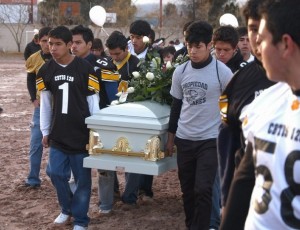 In Ciudad Juarez, Chihuahua, a student peace protester is gunned down by the Federal Police. Pictures of the intestines bursting from his ruptured gut make the rounds on the Internet, shocking even the world’s bloodiest city.
In Ciudad Juarez, Chihuahua, a student peace protester is gunned down by the Federal Police. Pictures of the intestines bursting from his ruptured gut make the rounds on the Internet, shocking even the world’s bloodiest city.
In Matamoros, Tamaulipas, schools close down after officials receive bomb threats. Newspapers timidly report that the threats “could be related to” Gulf Cartel retaliation for the killing of one of their leaders, Tony Tormenta, in a military operation days earlier. President Obama calls President Calderon to congratulate him on taking down the drug lord. Mexican authorities predict a new wave of violence in the state, as the Zetas move in to wrest control from the weakened Gulf Cartel.
Whether measured by increased public safety, reduced supply of illegal drugs on the U.S. market, or the dismantling of drug trafficking organizations, the war on drugs is failing. It has been four years since President Felipe Calderon announced the offensive and sent tens of thousands of soldiers into the streets. The results are a record 37,000 drug-war related homicides so far and thousands of complaints of human rights abuses by police and armed forces. Arrests of drug kingpins and lesser figures have set off violent turf wars, with no discernible effect on illicit flows. The murder of politicians, threats to civilians and disruption of daily life have furthered the downward spiral.
None of this should come as a surprise. Although Secretary of State Hillary Clinton has held up Plan Colombia as a model for Mexico, the drug war didn’t work there either. A full decade and $7 billion dollars after Plan Colombia began, regional drug production remains stable and smaller paramilitary groups have replaced the large cartels as traffickers. Some violent crimes, such as kidnappings, have gone down but corruption has deepened with scores of Congressional representatives under investigation, prosecution or sentencing for ties to paramilitaries.
Militarization with the combined rationale of the war on drugs and counterinsurgency has left Colombia with one of the worst human rights record in the hemisphere. Diplomatic relations have been affected as many neighboring nations view U.S. military presence and involvement in Colombia’s drug war as a threat to regional self-determination.
Despite these results, the Obama administration has announced plans to extend indefinitely the Merida Initiative, designed by the Bush administration to last three years and cost $1.3 billion dollars. The administration has requested $282 million for Mexico under the initiative in the 2012 budget.
The problem is, the drug war is not underfunded; it’s unwinnable. As long as a lucrative market exists, the cartels will find a way to serve it. Eliminating operatives, even high-level leaders, merely diversifies and redistributes the business. Cartels have years of experience building flexible structures, with new leaders or rival gangs replacing displaced or weakened ones. At the lower levels, they draw from an inexhaustible pool of young men with few prospects in life, who have adopted the slogan, “Better to die young and rich than old and poor.”
If the war on drugs is unwinnable, does that mean we have to resign ourselves to the unbridled power of the drug cartels?
No. The other tragedy of the war on drugs is that it precludes potentially more effective strategies by posing as the only option. As the U.S. government spends millions of taxpayer dollars to pay U.S. private security and defense firms to “fix” Mexico, it has done little to nothing to address the parts of transnational organized crime that exist within its borders—demand, transport and distribution, corrupt officials, gun-running and money laundering.
Rethinking the drug war is not tantamount to surrender. Here are a few key elements of an alternative strategy:
Follow the money. Instead of shoot-outs in the streets, far more could be done in both countries to attack the financial structures of criminal organizations. Billions of dollars are laundered in mainstream financial institutions and businesses. If we’re serious about weakening organized crime, it’s time to be serious about cracking down on illicit financial flows—even when it affects powerful interests.
Increase funding for drug abuse prevention and treatment. Approaching illegal drug use as a health issue is a win-win strategy. Education teaches young people the costs of addiction and abuse, and treatment and harm reduction programs can improve lives and reduce costs to society, as well as cutting demand for illicit substances.
End prohibition, beginning with marijuana. Without the billions of dollars in revenue that pot provides, drug cartels have fewer resources to recruit youth, buy arms and corrupt politicians.
Give communities a role besides “victim”. As Mexican funds and U.S. aid have been diverted to the drug war, social programs in Mexico have been severely cut back. This is exactly backward. Strong communities—ones with jobs, ample educational opportunities and coverage of basic needs and services–are better able to resist the infiltration of organized crime.
The war on drugs strategy lacks benchmarks or any real analysis of the root causes of the violence. Each day it digs itself deeper into a hole. That hole has become a mass grave for thousands of Mexicans, mostly youth.
The Obama administration has announced plans to intensify the drug war in Mexico and extend the model to Central American and Caribbean nations. Congress appears willing to follow suit. This would usher in a new era of military-led relations with our Latin American neighbors and unleash violent conflict in those countries as it has in Mexico.
If that happens, horror stories like the ones from Ciudad Juarez and Matamoros will sadly become the norm rather than the exception.
Laura Carlsen is director of the Americas Program of the Center for International Policy in Mexico City at www.americas.org.
This is an extended version of an article that originally appeared in the Dec. 27, 2010 edition of The Nation.



